From the observation tower in the Thar desert and as far as the eye can see, the dark blue arrays of a million solar panels can be seen sitting silently on the red dust. The Charanka solar park in Gujarat is an “ultra-mega” power project – the Indian government’s phrase – and the biggest in Asia.
But unlike the hundreds of coal plants and their noxious smokestacks being built in the country, the only danger linked to the solar panels are the snakes and scorpions that slink and scuttle between the sparse shrubs, posing a minor hazard to those who dust off the panels after dusk.
“But today, God is doing the cleaning,” says Poojan Ghodadra, programme manager for SunEdison, as rare, intense rain bounces off the panels. SunEdison has provided about a 10th of the 221MW total in the 5,000-acre solar park.
The project was the brainchild of Narendra Modi. As chief minister of Gujarat, Modi spurred companies to build more than 900MW of solar plant across the state in just a couple of years. Now, as prime minister, the question is whether he can repeat the feat across India, which receives more sunlight than any other country in the G20.
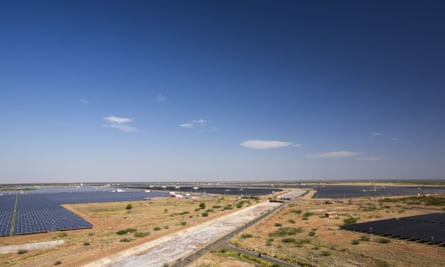
The answer matters across the globe: at the heart of tackling climate change is bringing power to the world’s poorest people without choking the planet with rising carbon emissions. The UN negotiations, which must deliver a deal to beat global warming by the end of 2015, began their crucial final stage on Tuesday in New York, with the assembly of more than 120 world leaders.
Boosting clean energy over dirty fossil fuels is high on the agenda and solar is booming, with new installations around the world doubling every two years. China is also aggressively pursuing the green technology, installing 12,000MW in 2013 – a record for any country in a single year.
As production goes up, panel costs are plummeting – down 80% since 2008, according to the New Climate Economy report released on 15 September. This puts solar on the edge of beating coal and gas on price.
Such energy choices are now on Modi’s desk: he has pledged to give electricity to every one of the 300 million Indians living in the dark, a feat he achieved on the smaller stage of Gujarat, and energy experts in India are impressed with the impetus given in his first 100 days to renewable energy, particularly solar. Three more ultra-mega solar parks were backed with cash in July, as were solar-powered irrigation pumps and canal-top solar plants. The electric fences on India’s sensitive northern borders will be solar-powered as the military installs 1,000MW of panels to replace expensive diesel generators across its posts. Another 7,000MW of solar is out for tender across the country and the rooftops of Delhi are to be bedecked with panels under a new scheme.
Elsewhere, glitzy new shopping malls in India’s blackout-prone cities are turning to solar for cheaper and more reliable energy, while thirsty Chennai is experimenting with solar-powered desalination.

Modi’s power minister, Piyush Goyal, says solar has a glittering future. The previous government’s target of 20,000MW of solar by 2022 will be smashed, he says. “It will be much, much larger. I think for India to add 10,000MW a year [of solar] and six, or seven or eight of wind every year is not very difficult to envisage.”
But coal has not gone away. Electricity produced by coal burning between June and August 2014 jumped 21% on 2013 and, despite corruption allegations, coal mining is increasing. The state coal company aims to double production to 1bn tonnes a year by 2019.
All acknowledge that coal must provide the steady power needed to underpin India’s rapid economic development: if the 360 million Indians living in poverty were a nation, it would be the third most populous on Earth. But the extent to which plummeting solar panel costs and their sometimes surprising fringe benefits help solar eat into coal’s share of the energy mix is crucial to keeping emissions down.
On a 15-metre-wide (50ft) irrigation canal that cuts through the green cotton and barley fields of Gujarat, another Modi project illustrates the extra benefits. Here, 3,600 solar panels stretch more than half a mile along the waterway, but do not just produce power. With water the critical resource for the farmers, the shading of the canal by the solar array saves an estimated 9m litres of water from evaporating each year while the cooling effect of the water under the panels edges up the electricity output.
Furthermore, the part of the canal in the sun is clogged with reeds but in the shade of the panels, the water flows freely. Spanning the canal, while adding cost, also avoids covering valuable farmland with panels. “The canal is the property of the government, so the cost of the land goes away too,” says Ghodadra.
Modi is known to enjoy talking about the world-first canal project to the presidents and prime ministers he meets around the world and has backed a national expansion. Even using just 10% of the canals in Gujarat would give 2,200MW of solar power. Along with millions of solar water pumps, Goyal says this pushing of power into the countryside will lift the income of poor farmers and increase food security by extending growing seasons.
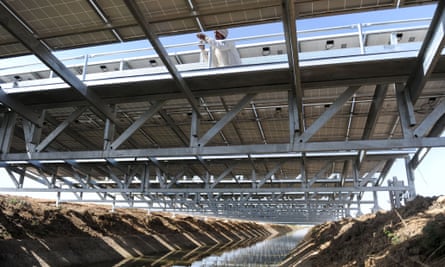
Solar power can also reach remote villages faster and cheaper than sending pylons striding across the land, says Pranav Mehta, chair of the National Solar Energy Federation of India. “The country needs more decentralised power, like rooftop solar, to reach the large parts of the country that the grid has not reached.”
India’s booming cities are another huge challenge, with many struggling with blackouts, particularly when temperatures soar and air conditioning is ramped up. Again, Modi’s 13-year tenure in Gujarat is providing the solar template. In September, it was announced that rooftop solar power projects in the state capital, Gandhinagar, will be replicated in Punjab and Delhi, where a storm at the end of May plunged its fragile grid into rolling blackouts for a week.
Delhi is ever more power-hungry, but with little open land and 300-plus days of sunshine a year, rooftop solar is an attractive solution. Since businessman SN Dwivedi put solar panels on his home, the previous back-up system has been silent. “I haven’t used the diesel generator in my house for a year,” he says.
Goyal says rural and urban off-grid solar are being looked at “very actively”.
“Offgrid is a very viable solution, especially for small, remote villages,” he says, while new assessment for his department calculates a potential for 120,000MW of rooftop solar across India. Other assessments are even higher at 200,000MW. The minister is certainly generating enthusiasm in the industry.
“We have a government that is even more bullish than the entrepreneurs,” says Rahul Munjal, scion of the Hero motorcycle family, the world’s biggest makers of two-wheelers. His new company, Hero Future Energies, will complete 280MW of solar by 2015, three years after it started.
“The Modi factor is very real with solar. He recognises that not only is solar very clean, it is also very fast to build,” says Pashupathy Gopalan, SunEdison’s managing director in south Asia and Africa. He says the cost of solar versus coal – the critical immediate factor – is near a tipping point. “Grid parity”, ie equal cost, has already been achieved for commercial and industrial customers putting panels on their roofs, Gopalan says, and is coming soon for other users.
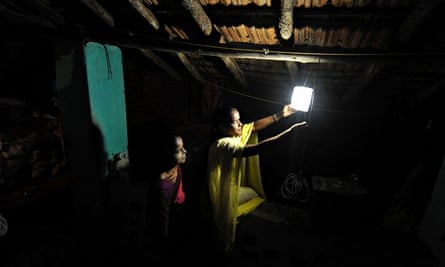
Bloomberg predicts parity for solar in India by 2020, while solar consultancy Bridge to India suggests 2018. “I think the grid parity debate is history now,” says Gopalan.
Grid parity would mean solar subsidies could be phased out, but Mehta notes that fossil fuels still get more than $40bn (£24bn) in subsidy every year in India: “You give me [a fraction] of that and I will make solar affordable and available everywhere.”
But despite highlighting the advantages of solar power – and new incentives to close old and dirty coal plants – energy minister Goyal is unable to pledge that the proportion of electricity generated from coal will fall from its current 65% in the coming years.
“I would love it to be lower,” he says. “But the ambitious plans India has to expand infrastructure, create jobs, improve the lives of people, get 24/7 power in every home, I think considering the huge magnitude of the demand shift, for renewables to meet this kind of demand will have serious challenges. So I would imagine coal also would have to expand in a very rapid way.” Even solar champion Mehta agrees, expecting the proportion to be unchanged in 2030.
Goyal says a key obstacle to ensuring solar power grabs its huge opportunity in India is getting the up-front capital at affordable interest rates – coal is relatively easy to fund, he says. The provision of clean energy finance will be a central one in the UN negotiations, which must deliver a global climate change deal by the end of 2015. Developing nations will demand financial help for green power projects from the industrialised west, in return for forgoing some of the fossil fuel burning on which the west itself grew rich. But there has been little progress so far, Goyal says: “So far I have yet to see any significant offers or proposal of support from the west.”Rajendra Pachauri is an expert on India’s energy system and the challenge of global warming, as head of the Delhi-based Energy and Resources Institute (Teri) and chair of the Intergovernmental Panel on Climate Change, which provides the world’s governments with their most definitive assessments. He thinks coal power expansion in India is likely to choke on supply problems, boosting the attractiveness of solar and other renewables. “It is a myth that India can continue to produce more coal,” he says, noting the shortage of coal that is leaving many plants stranded even today. “We have set up power stations in this country and there is no coal to run them.”
Pachauri is optimistic India under Modi can follow the cleaner energy path. “We have a prime minister who first, believes in climate change and, secondly, is a doer. It is a unique opportunity,” he says. “I believe you will see a snowballing of renewable energy developments in India in the next few years.”
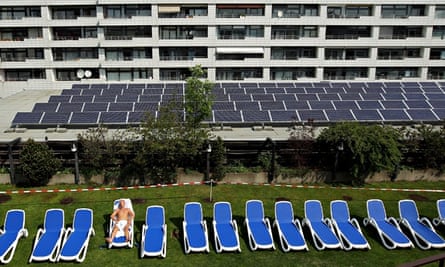
But while a step-change in clean energy generation is a must if global warming is to be tamed, climate change does not have to be the principle reason for change, according to Pachauri. “I don’t think India is really [expanding renewable energy] to limit greenhouse gas emissions. Here it is happening largely because renewables will turn out to be the most feasible and most attractive form of energy supply.”
He then paraphrases Deng Xiaoping’s famous quote: “It doesn’t matter if a cat is white or black, as long as it catches mice.” Whether the world is prepared to capture enough mice – carbon emissions – to avert catastrophic climate change is what is at stake in the next 15 months of global UN negotiations.
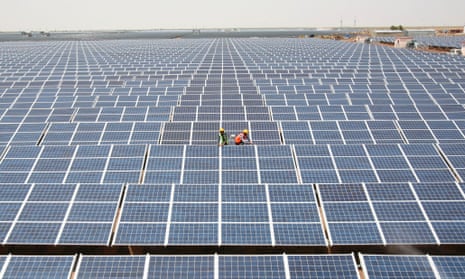
Comments (…)
Sign in or create your Guardian account to join the discussion